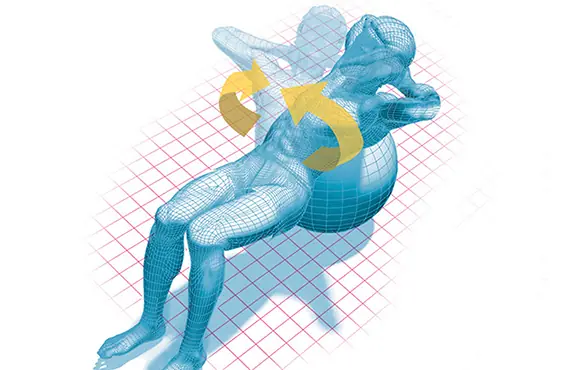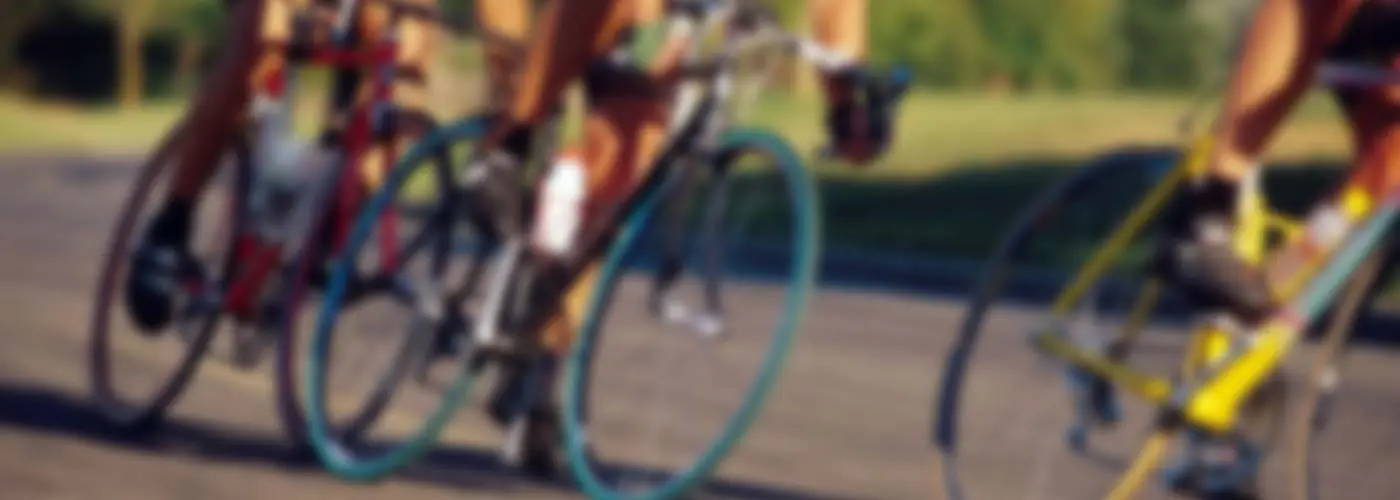More: Keep Your Hands Pain-Free on Your Ride
"You can have all the leg strength in the world, but without a stable core you won't be able to use it efficiently," says Graeme Street, founder of Cyclo-CORE, a DVD-based training program, and a personal trainer in Essex, Connecticut. "It's like having the body of a Ferrari with a Fiat chassis underneath."
What's more, a solid core will help eliminate unnecessary upper-body movement, so that all the energy you produce is delivered into asmooth pedal stroke.
More: Bigger Can Be Better for Road Tires, Too
Sadly, cycling's tripod position, in which the saddle, pedals, and handlebar support your weight, relies on core strength but doesn't build it. To develop your high-performance chassis, try this intense routine, designed by Street. It takes only about 10 minutes to complete and focuses on the transverse abdominus, the innermost abdominal muscle, which acts as a stabilizing girdle around your torso, and also on your lower back, obliques, glutes, hamstrings and hip flexors, so your entire core—and then some—becomes strong and works as a unit. You'll notice that it skips the rectus abdominus, or six-pack muscle, because, says Street, "it's the least-functional muscle for cycling." Do this intense routine, in this order, three times a week to create a core that lets you ride faster, longer, more powerfully—and finish stronger than ever.
Read the original article published on Bicycling.com.
Boxer Ball Crunch
1 of 9
What It Works: Transverse abdominus, obliques, lower back
- Lie with the middle of your back on a stability ball, your knees bent 90 degrees and your feet flat on the floor. Place your hands behind your head, but don't pull on your neck.
- Squeezing your belly button toward your spine, lift your upper back off the ball. Keeping your shoulders off the ball, trace a clockwise oval with your torso. Apply pressure with your lower back to keep the ball still through the entire motion. After 15 clockwise ovals, trace 15 counterclockwise.
Why It Works: Despite the straightforward motion of the bike, your body moves in three directions: forward as you head down the road, vertically as your legs pedal up and down, and laterally as your hips and upper body rock side to side. "This fluid, circular exercise builds control," says Street, and that helps you minimize lateral torsion and wasted motion.
Find
Cycling EventsPower Bridge
2 of 9
What It Works: Hip flexors, glutes, lower back
- Lying on your back, bend your knees and place your heels near your glutes. Arms are at your sides, palms down.
- In one smooth motion, squeeze your glutes, raise your hips off the floor and push up from your heels to form a straight line from shoulders to knees; toes come off the floor slightly. Hold for two seconds. Keeping your toes raised, lower yourself three-quarters of the way to complete one rep. Do 20 repetitions.
Why It Works: In addition to stretching the hip flexors, often extremely stiff in cyclists, the bridge strengthens the link between your lower back and glutes.
Find
Cycling EventsHip Extension
3 of 9
What It Works: Lower back, hamstrings, glutes
- Lying with your hips and stomach on the stability ball, put your hands on the floor directly under your shoulders, and extend your legs with toes resting on the floor.
- With a straight spine and shoulder blades back, as if you're trying to make them touch, lift both legs off the floor, keeping them straight. If possible, raise them slightly higher than parallel to the floor. Hold for two seconds and lower. Do 20 reps.
Why It Works: This movement builds backside strength, for added efficiency on the second half of the pedal stroke.
Find
Cycling EventsPlank
4 of 9
What It Works: Transverse abdominus, upper and lower back
- Lying on your stomach, place your elbows under your shoulders with forearms and hands on the floor.
- Lift your hips off the floor, keeping your back straight and abs tight, and rest on your toes. Aim for 60 seconds.
Why It Works: The plank builds the strength and muscular endurance you need to ride powerfully in the drops or in an aero position long after others have surrendered to the top of the handlebar.
Find
Cycling EventsTransverse Plank
5 of 9
What It Works: Transverse abdominus and obliques
- Lie on your right side, with your right elbow under your shoulder, forearm in front for stability, and stack your left foot on your right. Raise your left arm over your head.
- In one motion, lift your hips to create a straight line down your left side. Lower your hips a few inches off the floor; do 10 to 15 reps, then switch sides.
Why It Works: Strong obliques improve your stability in the saddle, letting you take on hairpin corners with more control and speed.
Find
Cycling EventsScissors Kick
6 of 9
What It Works: Transverse abdominus, hip flexors, inner and outer thighs
- Lying on your back with legs straight, place both hands palms down under your lower back.
- Pushing your elbows down into the floor and pulling your belly button toward your spine, raise your shoulders off the floor and look toward the ceiling. Raise your legs 4 inches off the ground and scissor them: left leg over right, then right over left. That's one rep. Work up to 100.
Why It Works: A comprehensive movement that connects key cycling muscles, the kick also builds inner-thigh muscles, which help you achieve hip, knee and forefoot alignment for a proper and efficient pedal stroke.
Find
Cycling EventsCatapult
7 of 9
What It Works: Entire core
- Sitting with a slight bend in your knees, press your heels against the floor. Extend arms to the front at shoulder height, palms facing each other.
- With a straight spine and upward gaze, inhale deeply, then exhale and slowly lower your torso to the floor over five counts as you inhale. Arms are overhead.
- In one smooth movement, leading with the arms, exhale and explode back to the starting position. Do 20 reps.
Why It Works: Contrary to its name, the catapult encourages supreme body control.
Find
Cycling EventsBoat Pose
8 of 9
What It Works: Transverse abdominus, lower back
- Sit, resting both hands lightly behind you, and lean back until your torso is at a 45-degree angle.
- Keeping your legs together, lift them off the floor as you extend arms forward at shoulder height. Abs are tight, as thighs and torso form a 90-degree angle. If your hamstrings are tight, you'll need to bend your knees a little. Work up to holding for 60 seconds.
Why It Works: As with the plank, this pose builds the lower-back stability and core strength needed to remain bent over the handlebar for hours, or to blast up hills without compromising power or speed.







Discuss This Article